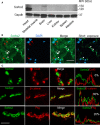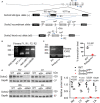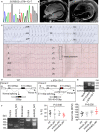Knockout of SORBS2 Protein Disrupts the Structural Integrity of Intercalated Disc and Manifests Features of Arrhythmogenic Cardiomyopathy
- PMID: 32808564
- PMCID: PMC7660791
- DOI: 10.1161/JAHA.119.017055
Knockout of SORBS2 Protein Disrupts the Structural Integrity of Intercalated Disc and Manifests Features of Arrhythmogenic Cardiomyopathy
Abstract
Background Sorbs2b (sorbin and SH3 domain-containing 2b) was recently identified as a cardiomyopathy gene from a zebrafish mutagenesis screen. However, cardiac functions of its mammalian ortholog remain elusive. Methods and Results We conducted a detailed expression and subcellular localization analysis of Sorbs2 ortholog in mice and a phenotypic characterization in Sorbs2 knockout mice. Sorbs2 is highly expressed in the mouse heart and encodes an adhesion junction/desmosome protein that is mainly localized to the intercalated disc. A mutation with near complete depletion of the Sorbs2 protein in mice results in phenotypes characteristic of human arrhythmogenic cardiomyopathy (ACM), including right ventricular dilation, right ventricular dysfunction, spontaneous ventricular tachycardia, and premature death. Sorbs2 is required to maintain the structural integrity of intercalated disc. Its absence resulted in profound cardiac electrical remodeling with impaired impulse conduction and action potential derangements. Targeted sequencing of human patients with ACM identified 2 rare splicing variants classified as likely pathogenic were in 2 unrelated individuals with ACM from a cohort of 59 patients with ACM. Conclusions The Sorbs2 knockout mouse manifests several key features reminiscent of human ACM. Although the candidacy of SORBS2 as a new ACM-susceptibility gene is supported by preliminary human genetics study, future validation in larger cohorts with ACM is needed.
Keywords: arrhythmogenic cardiomyopathy; intercalated disc; sorbin and SH3 domain‐containing 2; susceptibility gene.
Conflict of interest statement
None.
Figures






Similar articles
-
Knockout of Sorbin And SH3 Domain Containing 2 (Sorbs2) in Cardiomyocytes Leads to Dilated Cardiomyopathy in Mice.J Am Heart Assoc. 2022 Jul 5;11(13):e025687. doi: 10.1161/JAHA.122.025687. Epub 2022 Jun 22. J Am Heart Assoc. 2022. PMID: 35730644 Free PMC article.
-
Changes in ion channel expression and function associated with cardiac arrhythmogenic remodeling by Sorbs2.Biochim Biophys Acta Mol Basis Dis. 2021 Dec 1;1867(12):166247. doi: 10.1016/j.bbadis.2021.166247. Epub 2021 Sep 4. Biochim Biophys Acta Mol Basis Dis. 2021. PMID: 34487812 Free PMC article.
-
Novel Desmin Mutation p.Glu401Asp Impairs Filament Formation, Disrupts Cell Membrane Integrity, and Causes Severe Arrhythmogenic Left Ventricular Cardiomyopathy/Dysplasia.Circulation. 2018 Apr 10;137(15):1595-1610. doi: 10.1161/CIRCULATIONAHA.117.028719. Epub 2017 Dec 6. Circulation. 2018. PMID: 29212896
-
The cardiac desmosome and arrhythmogenic cardiomyopathies: from gene to disease.Circ Res. 2010 Sep 17;107(6):700-14. doi: 10.1161/CIRCRESAHA.110.223412. Circ Res. 2010. PMID: 20847325 Review.
-
Arrhythmogenic Cardiomyopathy in 2018-2019: ARVC/ALVC or Both?Heart Lung Circ. 2019 Jan;28(1):164-177. doi: 10.1016/j.hlc.2018.10.013. Epub 2018 Oct 24. Heart Lung Circ. 2019. PMID: 30446243 Review.
Cited by
-
Sorbs2 Deficiency and Vascular BK Channelopathy in Diabetes.Circ Res. 2024 Mar 29;134(7):858-871. doi: 10.1161/CIRCRESAHA.123.323538. Epub 2024 Feb 16. Circ Res. 2024. PMID: 38362769 Free PMC article.
-
Identification of candidate cardiomyopathy modifier genes through genome sequencing and RNA profiling.Front Cardiovasc Med. 2025 Jul 28;12:1546493. doi: 10.3389/fcvm.2025.1546493. eCollection 2025. Front Cardiovasc Med. 2025. PMID: 40791945 Free PMC article.
-
Exogenous mitochondrial transfer and endogenous mitochondrial fission facilitate AML resistance to OxPhos inhibition.Blood Adv. 2021 Oct 26;5(20):4233-4255. doi: 10.1182/bloodadvances.2020003661. Blood Adv. 2021. PMID: 34507353 Free PMC article.
-
A phenotype-based forward genetic screen identifies Dnajb6 as a sick sinus syndrome gene.Elife. 2022 Oct 18;11:e77327. doi: 10.7554/eLife.77327. Elife. 2022. PMID: 36255053 Free PMC article.
-
Transcriptomic Profiling of Canine Atrial Fibrillation Models After One Week of Sustained Arrhythmia.Circ Arrhythm Electrophysiol. 2021 Aug;14(8):e009887. doi: 10.1161/CIRCEP.121.009887. Epub 2021 Jul 16. Circ Arrhythm Electrophysiol. 2021. PMID: 34270327 Free PMC article.
References
-
- Gandjbakhch E, Redheuil A, Pousset F, Charron P, Frank R. Clinical diagnosis, imaging, and genetics of arrhythmogenic right ventricular cardiomyopathy/dysplasia: JACC state-of-the-art review. J Am Coll Cardiol. 2018;72:784–804. - PubMed
-
- Corrado D, Basso C, Pavei A, Michieli P, Schiavon M, Thiene G. Trends in sudden cardiovascular death in young competitive athletes after implementation of a preparticipation screening program. JAMA. 2006;296:1593–1601. - PubMed
-
- Thiene G, Nava A, Corrado D, Rossi L, Pennelli N. Right ventricular cardiomyopathy and sudden death in young people. N Engl J Med. 1988;318:129–133. - PubMed
-
- Bennett RG, Haqqani HM, Berruezo A, Della Bella P, Marchlinski FE, Hsu CJ, Kumar S. Arrhythmogenic cardiomyopathy in 2018–2019: ARVC/ALVC or both? Heart Lung Circ. 2019;28:164–177. - PubMed
-
- McKoy G, Protonotarios N, Crosby A, Tsatsopoulou A, Anastasakis A, Coonar A, Norman M, Baboonian C, Jeffery S, McKenna WJ. Identification of a deletion in plakoglobin in arrhythmogenic right ventricular cardiomyopathy with palmoplantar keratoderma and woolly hair (Naxos disease). Lancet. 2000;355:2119–2124. - PubMed
Publication types
MeSH terms
Substances
Grants and funding
LinkOut - more resources
Full Text Sources
Medical
Molecular Biology Databases

